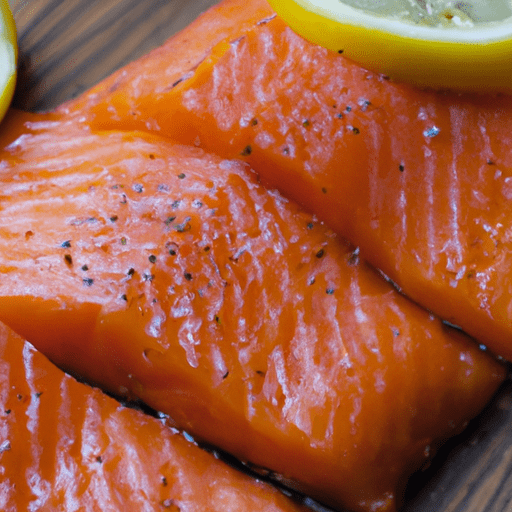The Delights of Trout Fillet: A Taste of Freshwater Delicacy
Trout fillet is a culinary gem that delights the taste buds of seafood enthusiasts around the world. With its delicate flavor, firm yet flaky texture, and versatility, it has become a favorite among chefs and home cooks alike. In this article, we will dive deep into the world of trout fillet, exploring its taste, common uses in cooking, nutritional value, and some interesting history and facts.
The Taste of Trout Fillet
Trout fillet offers a unique taste that balances richness and freshness. Its flavor profile is often described as mild, slightly nutty, and subtly sweet. The flesh of trout is tender and smooth, with a subtle earthiness that comes from its freshwater habitat. The taste is not overpowering, making it an excellent choice for those who prefer a more delicate seafood experience.
Common Uses in Cooking
Trout fillet’s versatility makes it a star ingredient in various culinary creations. Whether grilled, baked, poached, or pan-seared, trout fillet adapts beautifully to different cooking methods. Its delicate flavor pairs well with a wide range of ingredients, allowing for endless possibilities in the kitchen.
One popular way to enjoy trout fillet is by simply grilling or pan-searing it with a squeeze of lemon juice, a sprinkle of salt, and a touch of black pepper. This simple preparation method allows the natural flavors of the fish to shine through, creating a delightful combination of smokiness and freshness.
Trout fillet is also an excellent choice for incorporating into salads, pasta dishes, and stews. Its flaky texture holds up well in these preparations, adding a delightful element to the overall dish.
Nutritional Value
Beyond its culinary appeal, trout fillet also offers numerous health benefits. It is a great source of high-quality protein, which is essential for building and repairing tissues in the body. Additionally, trout fillet is rich in omega-3 fatty acids, which are known for their heart-healthy properties and their role in brain function.
Trout fillet is also a good source of vitamins and minerals, including vitamins B6, B12, and D, as well as selenium and potassium. These nutrients play vital roles in maintaining overall health and well-being.
History and Interesting Facts
Trout has a long-standing history as a prized catch in fishing, dating back centuries. The art of trout fishing has been passed down through generations, and various cultures worldwide have developed unique techniques to catch this elusive fish.
Trout is often associated with pristine freshwater environments, such as rivers, streams, and lakes. These habitats contribute to the fish’s excellent flavor and nutritional content. It’s worth noting that trout are highly sensitive to water quality, making sustainable fishing practices and maintaining clean water sources crucial for their continued existence.
Did you know that trout is often referred to as the “jewel of freshwater”? This nickname speaks to its remarkable taste and the beauty it brings to culinary creations. Additionally, trout belongs to the same family as salmon and char, which are further evidence of the fish’s esteemed status in the world of seafood.
Trout fillet is a delightful freshwater delicacy that offers a mild yet distinctive flavor. Its versatility in the kitchen allows for endless creative possibilities, making it a favorite among chefs and home cooks. Not only is it a culinary delight, but it also boasts impressive nutritional value.
Whether you choose to grill it, bake it, or include it in your favorite dish, trout fillet is sure to leave your taste buds craving more. So next time you have the chance, give trout fillet a try and immerse yourself in the wonders of this freshwater jewel.
Trout Fillet
Origin: Trout is a common name for several species of freshwater fish belonging to the Salmonidae family. The exact origin of trout is difficult to trace as different species are found in various regions around the world. They are widely distributed in North America, Europe, and Asia.
Common Uses: Trout fillets are versatile and can be prepared in various ways, including grilling, baking, broiling, poaching, or pan-frying. They are often seasoned with herbs, spices, or citrus flavors. Trout fillets can be enjoyed on their own, used in sandwiches, salads, pastas, or incorporated into other dishes.
Nutritional Benefits: Trout fillet is a nutrient-dense food with several health benefits. It is an excellent source of high-quality protein, omega-3 fatty acids, vitamin D, vitamin B12, and selenium. Omega-3 fatty acids are known for their potential positive effects on heart health, brain function, and reducing inflammation.
Unique Properties: Trout fillets have a delicate texture and a mild, slightly nutty flavor. The flesh of trout can vary in color from pink to orange, depending on the species and diet. This color is due to natural pigments and carotenoid compounds present in their food sources. Trout is also known for its lean, low-calorie profile, making it a healthy choice for those looking to maintain a balanced diet.
Historical Significance: Trout has been enjoyed as a food source for centuries. In Europe, trout has a long history, with records dating back to ancient Roman times. In the United States, trout became popular in the late 19th and early 20th centuries due to initiatives by fish and game agencies to introduce and promote trout fishing. Today, trout is commonly enjoyed by people around the world for its taste and versatility in cooking.




Use the share button below if you liked it.
It makes me smile, when I see it.